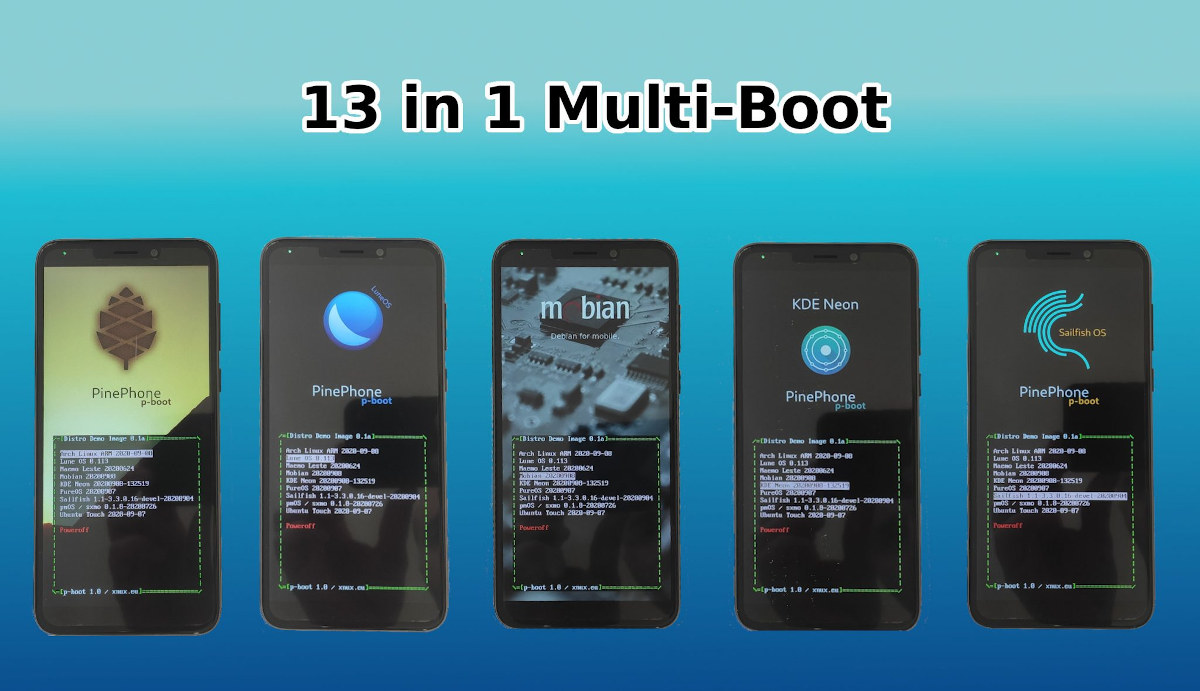You’ve certainly heard about dual-boot systems with Windows and Linux, and possibly about triple-boot systems with an extra OS like Chromium OS or Android, but pine64’s forum user Megous has gone much further with a multiboot image for Pinephone able to boot 13 different Linux distributions!
You’d think the image would occupy a lot of space on the device, but since all 13 distributions share the same Linux 5.9 kernel, all 13 operating systems fit on the internal eMMC flash or a MicroSD card with 8GB or greater capacity.
The image is based on the p-boot bootloader allowing you to select the distribution of your choice and supports all PinePhones from the Braveheart Edition to the most recent revisions with 3GB RAM and 32GB storage.
So what Linux distributions are supported by the multiboot image exactly? Here’s the list:
- Arch Linux Arm 2020-09-08
- Lune OS 0.113
- Maemo Leste 20200906
- Mobian 20200912
- KDE Neon 20200912-132511
- pmOS / fbkeyboard 2020-09-11
- pmOS / GNOME 2020-09-11
- pmOS / Phosh 2020-09-11
- pmOS / Plasma Mobile 2020-09-11
- PureOS 20200908
- Sailfish 1.1-3.3.0.16-devel-20200909
- pmOS / sxmo 0.1.8-20200726
- Ubuntu Touch 2020-09-10
That means you could easily try out different distros or desktop environment, without having to juggle with multiple microSD cards or reflash the internal flash. You can check out a short demo filmed a few days ago with “only” 9 distros.
Megous explains the image is based on btrfs subvolumes and file level deduplication, so if something goes wrong, it’s easy to revert each distribution to original state using pre-created btrfs snapshots.
If you’d like to go ahead, Pinephone multiboot image (5GB compressed) can be downloaded via Bittorrent or an HTTP mirror, and flashed with tools like dd, USBImager (recommended), or balenaEtcher. You’ll find the full details on the project’s website.
If you haven’t had the chance to purchase a PinePhone just yet, Pine64 has announced that pre-orders for PinePhone Manjaro Community Edition will start on September 17. You may want to read the latest Pine64 update to find out more about all other developments from the communiy.

Jean-Luc started CNX Software in 2010 as a part-time endeavor, before quitting his job as a software engineering manager, and starting to write daily news, and reviews full time later in 2011.
Support CNX Software! Donate via cryptocurrencies, become a Patron on Patreon, or purchase goods on Amazon or Aliexpress






Maybe not on phones but on a PC you can easily try different distro’s using lxc (linux containers)
Would this make the Pinephone less hack-able by “outsiders”?
Why?
What do you mean by hackable?
I have seen a Video about the $ 200 Pinephone, it was sadly laggy in ervery kind of responce. Does someone have real hands on experience with it?
You should not expect too much with a quad-core Cortex-A53 processor @ 1.x GHz, and Mali-400MP GPU, so I would not too surprised if it looks laggy on videos.
None of the linux distros is mature yet, most even still in alpha stage.
So expect some improvements from the sw side. It should eventually perform same as a entry level android phone. Just with all free software.
Some banks support only android app.
So, can we use android app?
It might be possible to run Android apps in Linux with Anbox.
Alternatively, the Glodroid project working on Android 10 for the PinePhone.
Be careful some banking apps rely on safety net status, so only unrooted google approved android will work. At least without nasty tweeks…
Here mostly all banks also offer a web access to banking.
I like that people fought for open formats/APIs in the past. Thanks to them it’s at least possible to interact with my government without having to use windows. I think the same should be done before it’s too late with the mobile OSes. Because if too many banks get used to this idiocy of tying people to a single mobile OS and proprietary app, it would be really unfortunate. Thankfully in my country it’s possible to find banks that give normal users JSON API access to their account by default, and most allow access over web (which is usually scrapable,… Read more »
Just a correction: it’s megous, not mengo. 🙂
Oops sorry about that. Fixed.
Mobile OSes are like buses, nothing for years, and then thirteen come along all at once.
why would the archive be 6gb and the raw image file 1.9gb? Is the point of compression not to shrink file size??? what the heck is the point of even archiving this then?